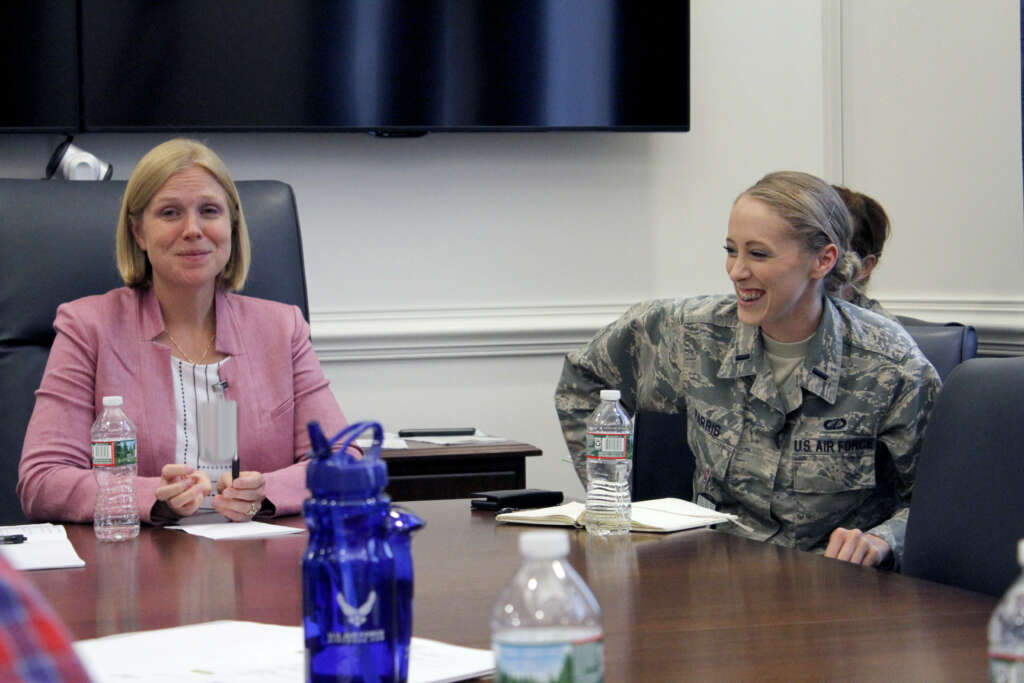
Cloud, network managed services giving Air Force glimpse of network future
Lauren Knausenberger, the chief transformation officer for the Air Force, said commercial network and cloud services will ensure the service stays modern, secur...
The two lynchpin initiatives under the Air Force’s network modernization effort are set to take major steps forward in 2020.
Through both the enterprise-IT-as-a-service (EITaaS) and the Cloud One platform, Air Force is taking an aggressive approach to fix systemic network issues.
The service’s path to speed up its path to the cloud through the Cloud One platform received a lift when the Government Accountability Office denied the protest by Leidos of the $727 million award to run Cloud One. The Air Force chose SAIC to migrate approximately 800 Air Force and U.S. Army mission applications into the cloud.
Meanwhile, the EITaaS project awarded to Accenture Federal Services a $66 million Other Transaction Agreement (OTA) in October to deliver these compute and store services to six bases including Maxwell in Alabama, Offutt in Nebraska and Joint Base Elmendorf-Richardson in Alaska.
This was the fourth award through OTAs that the Air Force made last year for the EITaaS proof of concept. AT&T, Unisys and Microsoft also are testing out this approach.

Lauren Knausenberger, the chief transformation officer for the Air Force, said both of these initiatives are about setting the foundational infrastructure in place and ensuring it will serve the service for decades.
“EITaaS is our big experiment to do that,” Knausenberger said on Ask the CIO. “We have selected some vendors who are household names, who are some of the best globally-recognized at what they do. Those folks have assessed our networks and how our base infrastructure has been set up. They are taking a completely holistic approach and have designed their proposal for what the future of our network should be.”
Knausenberger said their partners are bringing in the innovation when it comes to IT infrastructure.
“It’s a commercial-as-a-service model. Rather than paying for a bunch of hardware, software and bodies to manage a network at a point in time where we are then put in a position, like we have for much of the past few decades, of where quite frankly every time there is a mission decision to be made we say ‘let’s not invest in IT,’ we are paying on a subscription basis,” she said. “We are going to use commercial infrastructure. We are going to pay as a service. We are going to receive all the updates as they happen. We are going to 100% adopt modern architecture. We are going to own very little. We are going to use the services and the adaptation of the services. The idea is to be consistently be modern.”
Along with the Air Force, the Army and the Navy are looking at how they could use EITaaS. The Army issued a solicitation in July to modernize 200 bases around the world, starting with a nine-base pilot.
Knausenberger said the Air Force is working closely with the Army and Navy to share lessons learned.
“Even more so, everyone is now getting how intrinsically tied this is to the future of multi-domain command and control and multi-domain operations. We are now talking about those as components of one thing and working together in a much more collaborative way than ever before,” she said. “I often joke that this is probably one of the most boring things that we can talk about, but it’s the boring things that we have to tackle that truly will be game changing for the force in the future.”
Related Stories
“In a nutshell, Cloud One is our strategy for packaging cloud services and all of the security, identity and credential management, continuous monitoring and security operations center services in one place where people can go and easily request services and spin up an environment,” Knausenberger said. “We don’t have to have teams across the Air Force any longer trying to figure out in their stovepipe how do they stand up an Amazon Web Services or Microsoft Azure environment? How do I get it [approved under the] security technical implementation guides? How do I set up all of the continuous monitoring, security services and ICAM, single sign on? We were definitely being very inefficient in the way we were doing it in the past. Now we have a single team that one can go to to request service.”
She said this also means the Air Force now has a dev/sec/ops environments, meaning industry partners can begin developing capabilities much quicker. Over the long term, the capabilities will go into a catalog where airmen and women can find tools and applications that can be easily reused.
“What we had in the past is someone needed, say, a visualization tool and it needed to be accredited and bought separately,” she said. “We will finally have a centralized catalog of things where we know we will have a blanket purchase agreement, we know it’s accredited and we have a seamless process to accredit new tools and get those available in the catalog as well.”
In many ways, the Cloud One office is a “skilled, value-added broker” for the rest of the Air Force.
Copyright © 2024 Federal News Network. All rights reserved. This website is not intended for users located within the European Economic Area.
Jason Miller is executive editor of Federal News Network and directs news coverage on the people, policy and programs of the federal government.
Follow @jmillerWFED







